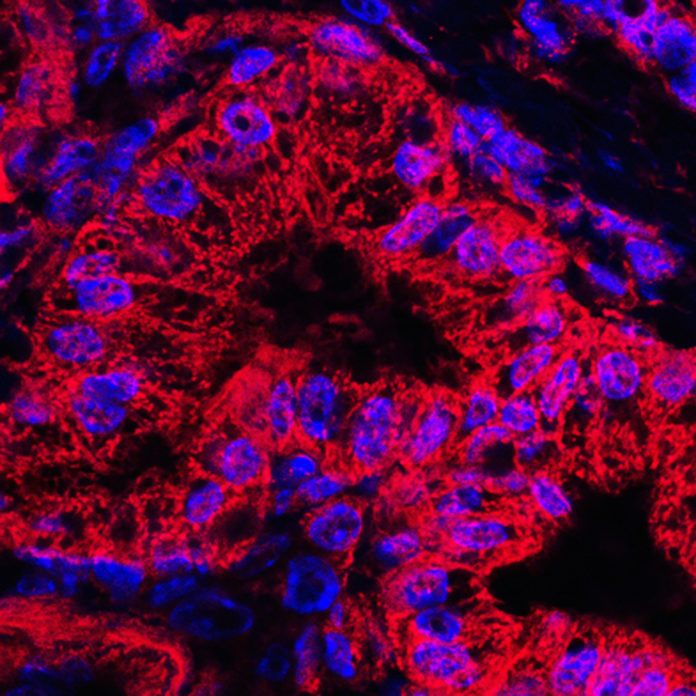
Scientists at the University of California, San Francisco, have found a way to target K-Ras-G12D mutations, which are especially prevalent in pancreatic ductal adenocarcinoma. This marks an important breakthrough as K-Ras mutations are were considered until recently, to be all but undruggable. But ever since the arrival of sotorasib and adagrasib—two FDA-approved K-Ras-G12C inhibitors—K-Ras mutations have had the distinction of being somewhat druggable.
The research team was led by Kevan Shokat, PhD, a professor in the department of cellular and molecular pharmacology. Back in 2013, Shokat and colleagues developed the first K-Ras-G12C inhibitors. And today, in Nature Chemical Biology, they present a paper (“Strain-release alkylation of Asp12 enables mutant selective targeting of K-Ras-G12D”) describing how they designed a candidate drug that could help make pancreatic cancer, which is almost always fatal, a treatable and perhaps even curable condition.
“[Covalent] inhibition of G12D, the most frequent K-Ras mutation particularly prevalent in pancreatic ductal adenocarcinoma, has remained elusive due to the lack of aspartate-targeting chemistry,” the article’s authors wrote. “Here we present a set of malolactone-based electrophiles that exploit ring strain to crosslink K-Ras-G12D at the mutant aspartate to form stable covalent complexes.”
A substituted malolactone developed by the scientists succeeded in targeting aspartate. Indeed, according to the researchers, the malolactone “rapidly crosslinked with the aspartate-12 of K-Ras in both GDP and GTP state.” The researchers added that targeting the GTP state “allowed effective suppression of downstream signaling and selective inhibition of K-Ras-G12D-driven cancer cell proliferation.” These effects were seen in vitro and in mouse models of cancer.
K-Ras mutations are extremely common in pancreatic cancer, explaining 90% of cases. Nearly half of all pancreatic cancers are caused by K-Ras-G12D, which also appears in some forms of lung, breast, and colon cancer. Pancreatic cancer is less common than these other cancers, but the lack of treatment options makes it more deadly, and it claims more than 50,000 lives each year in the United States.
“We’ve worked for 10 years to bring pancreatic cancer therapies up to speed with therapies for other cancers,” Shokat said. “This breakthrough is the first to target G12D and gives us a firm foothold to fight this devastating mutation.”
About half of the K-Ras mutations that cause pancreatic cancer are G12D, which differs from most other K-Ras mutations by a single amino acid substitution. This slight difference between healthy and cancer-causing proteins, in which glycine (G) becomes aspartate (D), presented a monumental challenge for chemists.
“There are very few molecules out there that can sense the difference between the cancer-causing aspartate and the glycine,” Shokat said. “To make good therapies, we need drugs that work on the tumor cells only, without affecting healthy cells.”
Shokat’s team envisioned a molecule that fit into a pocket of the K-Ras protein, then firmly—and irreversibly—bound to the rogue aspartate. The explosion of research that followed Shokat’s 2013 discovery enabled them to develop a template for chemicals that reliably found their way into that corner of the protein.
“Once we had that structure for our molecules, we knew they were sitting in the protein at the right spot,” Shokat said. “Then we could explore the little nooks and crannies that we needed to discover the chemistry of the aspartate.”
The scientists went through dozens of chemicals.
“It’s like climbing a new route on a mountain, you may be strong but the lengths of your arms limit what you can do,” Shokat said. “It was a lot of trial and error, tweaking the branches of these molecules to position them in this incredibly tight space around G12D. Some got close, then failed, and we would start over.”
Eventually, they found a winning molecule. It settled into the appropriate corner of K-Ras and bent into a new shape that reacted strongly with the aspartate.
The scientists are now optimizing the molecule to be durable enough to fight cancer in the human body. With the traction gained from this study, Shokat said, new therapies for pancreatic cancer could enter clinical trials in as little as two to three years.













